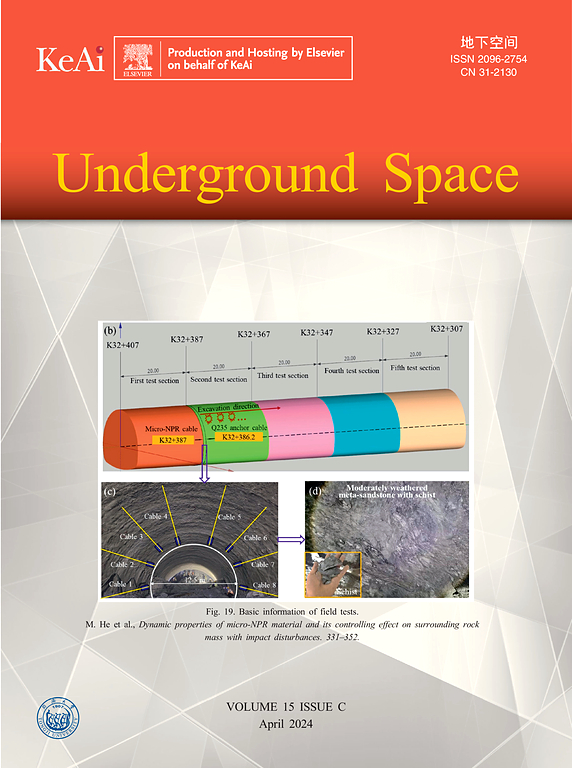Shield tunneling efficiency and stability enhancement based on interpretable machine learning and multi-objective optimization
IF 8.3
1区 工程技术
Q1 ENGINEERING, CIVIL
引用次数: 0
Abstract
Adequate control of shield machine parameters to ensure the safety and efficiency of shield construction is a difficult and complex problem. To address this problem, this paper proposes a hybrid intelligent optimization framework that combines interpretable machine learning, intelligent optimization algorithms, and multi-objective optimization and decision-making methods. The nonlinear relationship between the input parameters and ground settlement (GS) is fitted based on the light gradient boosting machine (LGBM), and the effect of the input parameters on GS is analysed based on SHapley additive exPlanation for further feature selection. Subsequently, the hyperparameters of LGBM were determined based on the sparrow search algorithm (SSA) to better fit the input–output relationship. On this basis, a multi-objective intelligent optimization model is established to solve the optimized operating parameters of shield machine by non-dominated sorting genetic algorithm II and technique for order preference by similarity to ideal solution to reduce GS and improve drilling efficiency. The results demonstrate that the SSA-LGBM model predicts GS with high accuracy, exhibiting an RMSE of 4.775, a VAF of 0.930 and an R2 of 0.931. These metrics collectively reflect the model’s excellent performance in prediction accuracy, ability to explain data variability, and control of prediction bias. The multi-objective optimization model is effective in optimizing two objectives, and the improvement can reach up to 39.38%; at the same time, the model has high scalability and can also be applied to three or more objectives. The intelligent optimization framework for shield construction parameters proposed in this paper can generate the optimal parameter combinations for shield machine manipulation, and provide reference and guidance when there are conflicting optimization objectives.
基于可解释机器学习和多目标优化的盾构掘进效率和稳定性提升
对盾构机参数进行充分的控制,以保证盾构施工的安全和效率是一个困难而复杂的问题。为了解决这一问题,本文提出了一种结合可解释机器学习、智能优化算法和多目标优化与决策方法的混合智能优化框架。基于光梯度增强机(LGBM)拟合了输入参数与地面沉降(GS)之间的非线性关系,并基于SHapley加性解释分析了输入参数对GS的影响,进一步进行特征选择。随后,基于麻雀搜索算法(SSA)确定LGBM的超参数,以更好地拟合输入输出关系。在此基础上,采用非主导排序遗传算法II和理想解相似性排序优先技术,建立盾构机多目标智能优化模型,求解盾构机优化后的运行参数,以降低GS,提高钻进效率。结果表明,SSA-LGBM模型预测GS具有较高的精度,RMSE为4.775,VAF为0.930,R2为0.931。这些指标共同反映了模型在预测精度、解释数据变异性的能力和预测偏差控制方面的出色表现。多目标优化模型对两个目标均有效,改进幅度可达39.38%;同时,该模型具有很高的可扩展性,也可以应用于三个或更多的目标。本文提出的盾构施工参数智能优化框架可以生成盾构机操作的最优参数组合,在优化目标冲突时提供参考和指导。
本文章由计算机程序翻译,如有差异,请以英文原文为准。
求助全文
约1分钟内获得全文
求助全文
来源期刊

Underground Space
ENGINEERING, CIVIL-
CiteScore
10.20
自引率
14.10%
发文量
71
审稿时长
63 days
期刊介绍:
Underground Space is an open access international journal without article processing charges (APC) committed to serving as a scientific forum for researchers and practitioners in the field of underground engineering. The journal welcomes manuscripts that deal with original theories, methods, technologies, and important applications throughout the life-cycle of underground projects, including planning, design, operation and maintenance, disaster prevention, and demolition. The journal is particularly interested in manuscripts related to the latest development of smart underground engineering from the perspectives of resilience, resources saving, environmental friendliness, humanity, and artificial intelligence. The manuscripts are expected to have significant innovation and potential impact in the field of underground engineering, and should have clear association with or application in underground projects.
 求助内容:
求助内容: 应助结果提醒方式:
应助结果提醒方式:


